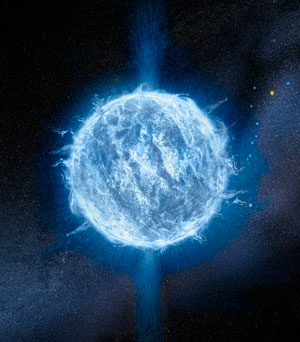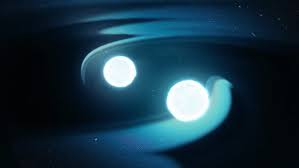Neutron Stars
In the previous blog we discussed the death of various sized stars and concluded that the death of massive stars results in the birth of two of the most extreme bodies in our universe - neutron stars and black holes. Today we'll talk about neutron stars.



Neutron star
The death of massive stars (also called supernova) could make either black holes or neutron stars.
When stars four to eight times as massive as the sun explode in a violent supernova, their outer layers can blow off in an often-spectacular display, leaving behind a small, dense core that continues to collapse. Gravity presses the material in on itself so tightly that protons and electrons combine to make neutrons, yielding the name "neutron star."
During the supernova, when the star implodes, particles like protons and electrons in the core, which really don't want to be close to each other, are forced to get close due to the mass of the star on top of it. These particles eventually fuse to become neutrons and are held very close to each other. An iron ball the size of our Earth is squeezed to a ball made of pure nuclear matter the size of a city. This forms a neutron star.
Neutron stars are the second most extreme (i.e. extreme in their properties) bodies in existence, second only to black holes.
- They have a mass of about million times our Earth, but are about 25 kilometers in diameter. It is so dense that one cubic centimeter of neutron star matter weighs more than all humans on Earth. That's about a billion tons of mass in the size of a sugar cube. A single teaspoon would weigh a billion tons — assuming you somehow managed to snag a sample without being captured by the body's strong gravitational pull.
- It has the strongest gravity apart from black holes. Light can bend around it, meaning you can see the front as well as parts of the back of it. It's surface temperature reaches a million degrees celsius compared to our sun's 6000. But the true bizzarity of the neutron star is inside it...
Though a neutron stars are star, in many ways, they're like planets, with solid crusts over a liquid core. In their crusts, the outermost layer is made of iron left over from the supernova with the subatomic particles squeezed in it with a sea of electrons flowing through them. As we go deeper, we find lesser and lesser protons as most has fused into neutrons. In the base of the crust, the gravity and pressure is so strong that the atomic nuclei start to touch and may join together. This is called gnocchi phase. As we go deeper, the protons and neutrons rearrange to make long cylinders of nuclear matter, called spaghetti phase. Then, there's sheets of nuclear material, called lasagna phase.
neutron star cross-section
Scientists refer to these layers as 'nuclear pasta'. 'Nuclear pasta' is so dense, it may be the strongest material in the universe, basically unbreakable. Finally after the nuclear pasta, we reach the core. We really don't know what happens to the properties of matter when it's squeezed so hard. Protons and neutrons might break further into an ocean of quarks (the smallest particle scientists know that makes up all of matter), a so called 'quark - gluon plasma' (will elaborate on later), some of those quarks might turn into 'strange quarks', with properties so extreme it requires an article to explain, or they might just stay protons and neutrons. This is all some heavy stuff, literally, so let's go back out to space.
Types of neutron stars:
Magnetars -
Magnetars are types of neutron stars with an exceptionally strong magnetic force. Magnetars have a magnetic force that is thousand times stronger than that of neutron stars and trillion times stronger than Earth's magnetic field and 100 million times stronger than the strongest magnet ever made on earth. Scientists have only discovered three such magnetars
Pulsars -
Pulsars are neutron stars that spin rapidly, releasing beams of light that sweep across space like a lighthouse. Scientist have observed 3000 pulsars.
Crashing Stars:
Here's another interesting fact - Some neutron stars are sort of 'friends' with other neutron stars. They share an orbit and move in circles. Eventually, energy is slowly radiated as gravitational waves, and their orbit decays. They get closer and closer to each other and eventually collide and kill each other in a monstrous kilonova explosion, spewing out a lot of their insides. These kilonova explosions bring about such extreme conditions that heavy nuclei are born again, not due to fusion, but the heavy neutron rich matter reassembling. This is how most of the heavy elements like gold, platinum etc. are formed. This kilonova eventually forms a black hole.
Neutron stars orbiting each other, eventually going to form a kilonova explosion.
Over millions of years, these leftover atoms mix back up into the galaxy. But, some atoms end up in a cloud which is eventually pulled back by gravity, forming another star and repeating the process all over again. Our solar system is one example, and the remains of the neutron stars are all around us. Our entire modern technological world is built of the elements that neutron stars made eons past....
So that is the story of neutron stars, the second most extreme bodies in our universe. In the next blog we'll talk about the most intriguing, extreme body - the black hole...
Very good information. Nicely written. Kudos Pranav...👍
ReplyDeleteThank you aunty!
DeleteThese details I never knew.. thank you Pranav for putting together in simple words.
ReplyDeleteThank you !
Deleteyo lit one fam!
ReplyDeletewaiting for the next blog
amazing article !!
ReplyDelete